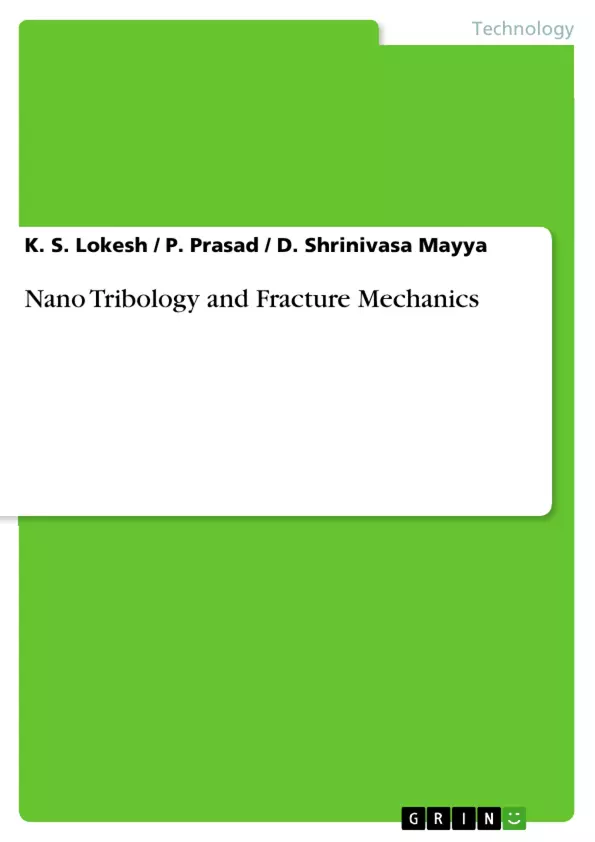
Nano Tribology and Fracture Mechanics
Fachbuch, 2018
69 Seiten, Note: A
Leseprobe
Inhaltsverzeichnis (Table of Contents)
- Chapter 1: Nanotechnology in Mechanical Engineering
- 1.1 Introduction
- 1.2 Scope of Nanotechnology in Mechanical Engineering
- 1.3 Fundamental Concepts in Nano Technology
- 1.4 Nanomaterials
- 1.5 Importance of Nano Materials:
- 1.6 Nano-composites - basic ingredients:
- 1.7 Nano composite
- 1.8 Significance and advantages
- 1.9 Nano Composites
- 1.10 Selected Application of Nano materials And Nanotechnology
- 1.11 Role of nano-structured materials in mechanical engineering applications;
- 1.12 Disadvantages of nano materials
- 1.13 Safety of nano materials
- 1.14 Introduction to nano mechanics
- Chapter 2: Mechanical Properties of Nano Materials
- Chapter 3: Introduction To Nano Tribology
- Chapter 4: Fracture of Nano Material
- Chapter 5: Advanced Nano Materials
Zielsetzung und Themenschwerpunkte (Objectives and Key Themes)
This work aims to provide a comprehensive overview of nano tribology and fracture mechanics, focusing on the applications of nanotechnology within mechanical engineering. It explores the properties of nanomaterials, their use in composites, and the challenges and advantages associated with their implementation.
- Nanotechnology applications in mechanical engineering
- Mechanical properties and behavior of nanomaterials
- Principles and applications of nano-tribology
- Fracture mechanisms in nanomaterials
- Advanced nanomaterials and their potential
Zusammenfassung der Kapitel (Chapter Summaries)
Chapter 1: Nanotechnology in Mechanical Engineering: This chapter introduces nanotechnology, defining its scope and highlighting its interdisciplinary nature. It explores both top-down and bottom-up approaches to nanomaterial construction, emphasizing the unique properties of nanomaterials compared to their larger-scale counterparts. The chapter further discusses the significant role of nanotechnology in mechanical engineering, detailing its potential to enhance material properties and create innovative applications in various industries, from information technology to medicine. Specific examples of nanomaterials and their uses are provided to illustrate the practical implications of this field.
Chapter 2: Mechanical Properties of Nano Materials: This chapter delves into the mechanical behavior of nanoparticles, exploring their unique characteristics compared to bulk materials. It likely covers topics such as the influence of size and shape on mechanical strength, stiffness, and ductility. The chapter would analyze the effects of defects and testing methods used to characterize the mechanical properties of these materials. Industrial considerations and different failure mechanisms for these materials at the nanoscale would also be addressed, providing a comprehensive understanding of their behavior under stress.
Chapter 3: Introduction To Nano Tribology: This chapter introduces the field of nano-tribology, defining it and outlining its significance. It likely explains the need for nano-tribology, given the unique frictional and wear characteristics of nanomaterials. The chapter would provide an overview of techniques used to study nano-tribology, such as atomic force microscopy (AFM). Specific applications of nano-tribology in current products would likely be discussed, emphasizing its relevance in various technological domains. The chapter connects concepts of friction, wear, and surface properties at the nanoscale.
Chapter 4: Fracture of Nano Material: This chapter focuses on the fracture behavior of nanomaterials, exploring different fracture mechanisms specific to the nanoscale. It would discuss the fracture of various nanomaterials, possibly including brittle thin films, gold nanoparticles, and silica nanoparticles, analyzing the effects of different substrates and processing techniques. The chapter would likely delve into the influence of material properties and structural features on the fracture toughness and overall failure modes. The analysis would provide insights into the factors contributing to the fracture behavior of nanomaterials and the associated implications.
Chapter 5: Advanced Nano Materials: This chapter explores advanced nanomaterials and their potential applications. It likely covers topics such as block copolymer systems, self-assembly processes, and novel composite materials incorporating carbon nanotubes (CNTs) and other nanostructures. The chapter would discuss the properties and synthesis methods of these advanced materials, along with examples of their uses in different applications. It provides an outlook on emerging trends and future challenges related to advanced nanomaterial development and implementation.
Schlüsselwörter (Keywords)
Nanotechnology, nano-tribology, fracture mechanics, nanomaterials, mechanical properties, nanocomposites, atomic force microscopy (AFM), friction, wear, failure mechanisms, advanced nanomaterials, carbon nanotubes (CNTs).
Frequently Asked Questions: Nanotechnology in Mechanical Engineering
What is the overall scope of this document?
This document provides a comprehensive preview of a publication on nanotechnology in mechanical engineering. It includes the table of contents, objectives and key themes, chapter summaries, and keywords. The preview is intended to give a thorough understanding of the book's content and focus.
What are the main topics covered in the book?
The book covers several key areas within nanotechnology and its application in mechanical engineering. These include: nanotechnology's scope in mechanical engineering; the mechanical properties of nanomaterials; an introduction to nano-tribology (the study of friction and wear at the nanoscale); fracture mechanics of nanomaterials; and advanced nanomaterials and their potential applications. The book also explores the use of nanomaterials in composites.
What are the objectives of this work?
The main objective is to offer a complete overview of nano-tribology and fracture mechanics, particularly within the context of mechanical engineering applications. It aims to explore the properties of nanomaterials, their use in composites, and the advantages and challenges of implementing them.
What are the key themes explored?
Key themes include the application of nanotechnology in mechanical engineering; the mechanical properties and behavior of nanomaterials; the principles and applications of nano-tribology; fracture mechanisms in nanomaterials; and advanced nanomaterials and their potential.
What is covered in Chapter 1: Nanotechnology in Mechanical Engineering?
Chapter 1 introduces nanotechnology, defining its scope and highlighting its interdisciplinary nature. It discusses top-down and bottom-up approaches to nanomaterial construction, emphasizing the unique properties of nanomaterials. The chapter details nanotechnology's significant role in mechanical engineering, explaining its potential for enhancing material properties and creating innovative applications.
What is discussed in Chapter 2: Mechanical Properties of Nano Materials?
Chapter 2 focuses on the mechanical behavior of nanoparticles, comparing their characteristics to bulk materials. It likely covers the influence of size and shape on mechanical strength, stiffness, and ductility, along with the effects of defects and testing methods. Industrial considerations and different failure mechanisms at the nanoscale are also addressed.
What does Chapter 3: Introduction To Nano Tribology cover?
Chapter 3 introduces nano-tribology, explaining its significance and outlining the unique frictional and wear characteristics of nanomaterials. It covers techniques used to study nano-tribology, such as atomic force microscopy (AFM), and discusses specific applications in various technological domains, connecting concepts of friction, wear, and surface properties at the nanoscale.
What is the focus of Chapter 4: Fracture of Nano Material?
Chapter 4 concentrates on the fracture behavior of nanomaterials, exploring fracture mechanisms specific to the nanoscale. It analyzes the fracture of various nanomaterials, considering the effects of different substrates and processing techniques. The chapter delves into how material properties and structural features influence fracture toughness and failure modes.
What are the contents of Chapter 5: Advanced Nano Materials?
Chapter 5 explores advanced nanomaterials and their potential applications. It likely covers block copolymer systems, self-assembly processes, and novel composite materials incorporating carbon nanotubes (CNTs) and other nanostructures. The chapter discusses properties, synthesis methods, and applications of these materials, providing an outlook on future trends and challenges.
What are the key words associated with this book?
Key words include: Nanotechnology, nano-tribology, fracture mechanics, nanomaterials, mechanical properties, nanocomposites, atomic force microscopy (AFM), friction, wear, failure mechanisms, advanced nanomaterials, carbon nanotubes (CNTs).
Details
- Titel
- Nano Tribology and Fracture Mechanics
- Hochschule
- Srinivas School of Engineering (Srinivas Institute of Technology)
- Veranstaltung
- Engineering
- Note
- A
- Autoren
- K. S. Lokesh (Autor:in), P. Prasad (Autor:in), D. Shrinivasa Mayya (Autor:in)
- Erscheinungsjahr
- 2018
- Seiten
- 69
- Katalognummer
- V453890
- ISBN (eBook)
- 9783668864443
- ISBN (Buch)
- 9783668864450
- Sprache
- Englisch
- Anmerkungen
- This book is written to contribute the major aspects of mechanical engineering in nano technology by combining the best practices of nano science in mechanical engineering field. This book designates the combined effort of Nano applications in Various themes of Mechanical Practices.
- Schlagworte
- nano tribology fracture mechanics
- Produktsicherheit
- GRIN Publishing GmbH
- Preis (Ebook)
- US$ 31,99
- Preis (Book)
- US$ 44,99
- Arbeit zitieren
- K. S. Lokesh (Autor:in), P. Prasad (Autor:in), D. Shrinivasa Mayya (Autor:in), 2018, Nano Tribology and Fracture Mechanics, München, Page::Imprint:: GRINVerlagOHG, https://www.diplomarbeiten24.de/document/453890
- Autor werden
- Ihre Optionen
- Vertriebskanäle
- Premium Services
- Autorenprofil
- Textarten und Formate
- Services für Verlage, Hochschulen, Unternehmen

- © GRIN Publishing GmbH.
- Alle Inhalte urheberrechtlich geschützt. Kopieren und verbreiten untersagt.
- info@grin.com
- AGB
- Open Publishing
Der GRIN Verlag hat sich seit 1998 auf die Veröffentlichung akademischer eBooks und Bücher spezialisiert. Der GRIN Verlag steht damit als erstes Unternehmen für User Generated Quality Content. Die Verlagsseiten GRIN.com, Hausarbeiten.de und Diplomarbeiten24 bieten für Hochschullehrer, Absolventen und Studenten die ideale Plattform, wissenschaftliche Texte wie Hausarbeiten, Referate, Bachelorarbeiten, Masterarbeiten, Diplomarbeiten, Dissertationen und wissenschaftliche Aufsätze einem breiten Publikum zu präsentieren.
Kostenfreie Veröffentlichung: Hausarbeit, Bachelorarbeit, Diplomarbeit, Dissertation, Masterarbeit, Interpretation oder Referat jetzt veröffentlichen!
- GRIN Verlag GmbH
-
- Nymphenburger Str. 86
- 80636
- Munich, Deutschland
- +49 89-550559-0
- +49 89-550559-10
- info@grin.com
-









